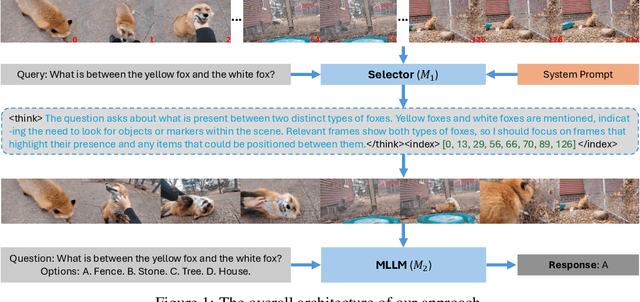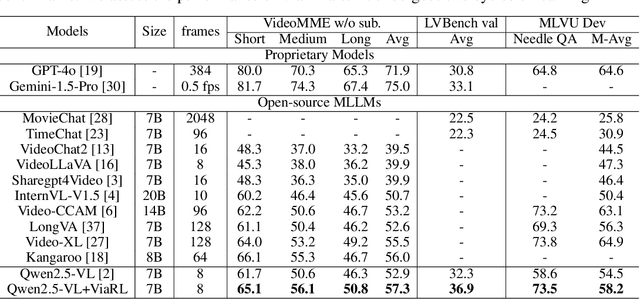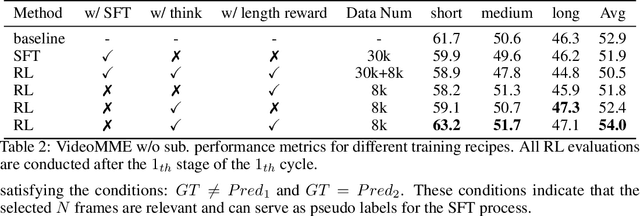Kai Qiu
Image Tokenizer Needs Post-Training
Sep 15, 2025Abstract:Recent image generative models typically capture the image distribution in a pre-constructed latent space, relying on a frozen image tokenizer. However, there exists a significant discrepancy between the reconstruction and generation distribution, where current tokenizers only prioritize the reconstruction task that happens before generative training without considering the generation errors during sampling. In this paper, we comprehensively analyze the reason for this discrepancy in a discrete latent space, and, from which, we propose a novel tokenizer training scheme including both main-training and post-training, focusing on improving latent space construction and decoding respectively. During the main training, a latent perturbation strategy is proposed to simulate sampling noises, \ie, the unexpected tokens generated in generative inference. Specifically, we propose a plug-and-play tokenizer training scheme, which significantly enhances the robustness of tokenizer, thus boosting the generation quality and convergence speed, and a novel tokenizer evaluation metric, \ie, pFID, which successfully correlates the tokenizer performance to generation quality. During post-training, we further optimize the tokenizer decoder regarding a well-trained generative model to mitigate the distribution difference between generated and reconstructed tokens. With a $\sim$400M generator, a discrete tokenizer trained with our proposed main training achieves a notable 1.60 gFID and further obtains 1.36 gFID with the additional post-training. Further experiments are conducted to broadly validate the effectiveness of our post-training strategy on off-the-shelf discrete and continuous tokenizers, coupled with autoregressive and diffusion-based generators.
Phi-Ground Tech Report: Advancing Perception in GUI Grounding
Jul 31, 2025



Abstract:With the development of multimodal reasoning models, Computer Use Agents (CUAs), akin to Jarvis from \textit{"Iron Man"}, are becoming a reality. GUI grounding is a core component for CUAs to execute actual actions, similar to mechanical control in robotics, and it directly leads to the success or failure of the system. It determines actions such as clicking and typing, as well as related parameters like the coordinates for clicks. Current end-to-end grounding models still achieve less than 65\% accuracy on challenging benchmarks like ScreenSpot-pro and UI-Vision, indicating they are far from being ready for deployment. % , as a single misclick can result in unacceptable consequences. In this work, we conduct an empirical study on the training of grounding models, examining details from data collection to model training. Ultimately, we developed the \textbf{Phi-Ground} model family, which achieves state-of-the-art performance across all five grounding benchmarks for models under $10B$ parameters in agent settings. In the end-to-end model setting, our model still achieves SOTA results with scores of \textit{\textbf{43.2}} on ScreenSpot-pro and \textit{\textbf{27.2}} on UI-Vision. We believe that the various details discussed in this paper, along with our successes and failures, not only clarify the construction of grounding models but also benefit other perception tasks. Project homepage: \href{https://zhangmiaosen2000.github.io/Phi-Ground/}{https://zhangmiaosen2000.github.io/Phi-Ground/}
ViaRL: Adaptive Temporal Grounding via Visual Iterated Amplification Reinforcement Learning
May 21, 2025



Abstract:Video understanding is inherently intention-driven-humans naturally focus on relevant frames based on their goals. Recent advancements in multimodal large language models (MLLMs) have enabled flexible query-driven reasoning; however, video-based frameworks like Video Chain-of-Thought lack direct training signals to effectively identify relevant frames. Current approaches often rely on heuristic methods or pseudo-label supervised annotations, which are both costly and limited in scalability across diverse scenarios. To overcome these challenges, we introduce ViaRL, the first framework to leverage rule-based reinforcement learning (RL) for optimizing frame selection in intention-driven video understanding. An iterated amplification strategy is adopted to perform alternating cyclic training in the video CoT system, where each component undergoes iterative cycles of refinement to improve its capabilities. ViaRL utilizes the answer accuracy of a downstream model as a reward signal to train a frame selector through trial-and-error, eliminating the need for expensive annotations while closely aligning with human-like learning processes. Comprehensive experiments across multiple benchmarks, including VideoMME, LVBench, and MLVU, demonstrate that ViaRL consistently delivers superior temporal grounding performance and robust generalization across diverse video understanding tasks, highlighting its effectiveness and scalability. Notably, ViaRL achieves a nearly 15\% improvement on Needle QA, a subset of MLVU, which is required to search a specific needle within a long video and regarded as one of the most suitable benchmarks for evaluating temporal grounding.
HiTVideo: Hierarchical Tokenizers for Enhancing Text-to-Video Generation with Autoregressive Large Language Models
Mar 14, 2025Abstract:Text-to-video generation poses significant challenges due to the inherent complexity of video data, which spans both temporal and spatial dimensions. It introduces additional redundancy, abrupt variations, and a domain gap between language and vision tokens while generation. Addressing these challenges requires an effective video tokenizer that can efficiently encode video data while preserving essential semantic and spatiotemporal information, serving as a critical bridge between text and vision. Inspired by the observation in VQ-VAE-2 and workflows of traditional animation, we propose HiTVideo for text-to-video generation with hierarchical tokenizers. It utilizes a 3D causal VAE with a multi-layer discrete token framework, encoding video content into hierarchically structured codebooks. Higher layers capture semantic information with higher compression, while lower layers focus on fine-grained spatiotemporal details, striking a balance between compression efficiency and reconstruction quality. Our approach efficiently encodes longer video sequences (e.g., 8 seconds, 64 frames), reducing bits per pixel (bpp) by approximately 70\% compared to baseline tokenizers, while maintaining competitive reconstruction quality. We explore the trade-offs between compression and reconstruction, while emphasizing the advantages of high-compressed semantic tokens in text-to-video tasks. HiTVideo aims to address the potential limitations of existing video tokenizers in text-to-video generation tasks, striving for higher compression ratios and simplify LLMs modeling under language guidance, offering a scalable and promising framework for advancing text to video generation. Demo page: https://ziqinzhou66.github.io/project/HiTVideo.
Robust Latent Matters: Boosting Image Generation with Sampling Error
Mar 11, 2025



Abstract:Recent image generation schemes typically capture image distribution in a pre-constructed latent space relying on a frozen image tokenizer. Though the performance of tokenizer plays an essential role to the successful generation, its current evaluation metrics (e.g. rFID) fail to precisely assess the tokenizer and correlate its performance to the generation quality (e.g. gFID). In this paper, we comprehensively analyze the reason for the discrepancy of reconstruction and generation qualities in a discrete latent space, and, from which, we propose a novel plug-and-play tokenizer training scheme to facilitate latent space construction. Specifically, a latent perturbation approach is proposed to simulate sampling noises, i.e., the unexpected tokens sampled, from the generative process. With the latent perturbation, we further propose (1) a novel tokenizer evaluation metric, i.e., pFID, which successfully correlates the tokenizer performance to generation quality and (2) a plug-and-play tokenizer training scheme, which significantly enhances the robustness of tokenizer thus boosting the generation quality and convergence speed. Extensive benchmarking are conducted with 11 advanced discrete image tokenizers with 2 autoregressive generation models to validate our approach. The tokenizer trained with our proposed latent perturbation achieve a notable 1.60 gFID with classifier-free guidance (CFG) and 3.45 gFID without CFG with a $\sim$400M generator. Code: https://github.com/lxa9867/ImageFolder.
Phi-4-Mini Technical Report: Compact yet Powerful Multimodal Language Models via Mixture-of-LoRAs
Mar 03, 2025Abstract:We introduce Phi-4-Mini and Phi-4-Multimodal, compact yet highly capable language and multimodal models. Phi-4-Mini is a 3.8-billion-parameter language model trained on high-quality web and synthetic data, significantly outperforming recent open-source models of similar size and matching the performance of models twice its size on math and coding tasks requiring complex reasoning. This achievement is driven by a carefully curated synthetic data recipe emphasizing high-quality math and coding datasets. Compared to its predecessor, Phi-3.5-Mini, Phi-4-Mini features an expanded vocabulary size of 200K tokens to better support multilingual applications, as well as group query attention for more efficient long-sequence generation. Phi-4-Multimodal is a multimodal model that integrates text, vision, and speech/audio input modalities into a single model. Its novel modality extension approach leverages LoRA adapters and modality-specific routers to allow multiple inference modes combining various modalities without interference. For example, it now ranks first in the OpenASR leaderboard to date, although the LoRA component of the speech/audio modality has just 460 million parameters. Phi-4-Multimodal supports scenarios involving (vision + language), (vision + speech), and (speech/audio) inputs, outperforming larger vision-language and speech-language models on a wide range of tasks. Additionally, we experiment to further train Phi-4-Mini to enhance its reasoning capabilities. Despite its compact 3.8-billion-parameter size, this experimental version achieves reasoning performance on par with or surpassing significantly larger models, including DeepSeek-R1-Distill-Qwen-7B and DeepSeek-R1-Distill-Llama-8B.
Logic-RL: Unleashing LLM Reasoning with Rule-Based Reinforcement Learning
Feb 20, 2025Abstract:Inspired by the success of DeepSeek-R1, we explore the potential of rule-based reinforcement learning (RL) in large reasoning models. To analyze reasoning dynamics, we use synthetic logic puzzles as training data due to their controllable complexity and straightforward answer verification. We make some key technical contributions that lead to effective and stable RL training: a system prompt that emphasizes the thinking and answering process, a stringent format reward function that penalizes outputs for taking shortcuts, and a straightforward training recipe that achieves stable convergence. Our 7B model develops advanced reasoning skills-such as reflection, verification, and summarization-that are absent from the logic corpus. Remarkably, after training on just 5K logic problems, it demonstrates generalization abilities to the challenging math benchmarks AIME and AMC.
Three-dimensional attention Transformer for state evaluation in real-time strategy games
Jan 07, 2025



Abstract:Situation assessment in Real-Time Strategy (RTS) games is crucial for understanding decision-making in complex adversarial environments. However, existing methods remain limited in processing multi-dimensional feature information and temporal dependencies. Here we propose a tri-dimensional Space-Time-Feature Transformer (TSTF Transformer) architecture, which efficiently models battlefield situations through three independent but cascaded modules: spatial attention, temporal attention, and feature attention. On a dataset comprising 3,150 adversarial experiments, the 8-layer TSTF Transformer demonstrates superior performance: achieving 58.7% accuracy in the early game (~4% progress), significantly outperforming the conventional Timesformer's 41.8%; reaching 97.6% accuracy in the mid-game (~40% progress) while maintaining low performance variation (standard deviation 0.114). Meanwhile, this architecture requires fewer parameters (4.75M) compared to the baseline model (5.54M). Our study not only provides new insights into situation assessment in RTS games but also presents an innovative paradigm for Transformer-based multi-dimensional temporal modeling.
MageBench: Bridging Large Multimodal Models to Agents
Dec 05, 2024Abstract:LMMs have shown impressive visual understanding capabilities, with the potential to be applied in agents, which demand strong reasoning and planning abilities. Nevertheless, existing benchmarks mostly assess their reasoning abilities in language part, where the chain-of-thought is entirely composed of text.We consider the scenario where visual signals are continuously updated and required along the decision making process. Such vision-in-the-chain reasoning paradigm is more aligned with the needs of multimodal agents, while being rarely evaluated. In this paper, we introduce MageBench, a reasoning capability oriented multimodal agent benchmark that, while having light-weight environments, poses significant reasoning challenges and holds substantial practical value. This benchmark currently includes three types of environments: WebUI, Sokoban, and Football, comprising a total of 483 different scenarios. It thoroughly validates the agent's knowledge and engineering capabilities, visual intelligence, and interaction skills. The results show that only a few product-level models are better than random acting, and all of them are far inferior to human-level. More specifically, we found current models severely lack the ability to modify their planning based on visual feedback, as well as visual imagination, interleaved image-text long context handling, and other abilities. We hope that our work will provide optimization directions for LMM from the perspective of being an agent. We release our code and data at https://github.com/microsoft/MageBench.
XQ-GAN: An Open-source Image Tokenization Framework for Autoregressive Generation
Dec 02, 2024



Abstract:Image tokenizers play a critical role in shaping the performance of subsequent generative models. Since the introduction of VQ-GAN, discrete image tokenization has undergone remarkable advancements. Improvements in architecture, quantization techniques, and training recipes have significantly enhanced both image reconstruction and the downstream generation quality. In this paper, we present XQ-GAN, an image tokenization framework designed for both image reconstruction and generation tasks. Our framework integrates state-of-the-art quantization techniques, including vector quantization (VQ), residual quantization (RQ), multi-scale residual quantization (MSVQ), product quantization (PQ), lookup-free quantization (LFQ), and binary spherical quantization (BSQ), within a highly flexible and customizable training environment. On the standard ImageNet 256x256 benchmark, our released model achieves an rFID of 0.64, significantly surpassing MAGVIT-v2 (0.9 rFID) and VAR (0.9 rFID). Furthermore, we demonstrate that using XQ-GAN as a tokenizer improves gFID metrics alongside rFID. For instance, with the same VAR architecture, XQ-GAN+VAR achieves a gFID of 2.6, outperforming VAR's 3.3 gFID by a notable margin. To support further research, we provide pre-trained weights of different image tokenizers for the community to directly train the subsequent generative models on it or fine-tune for specialized tasks.
 Add to Chrome
Add to Chrome Add to Firefox
Add to Firefox Add to Edge
Add to Edge